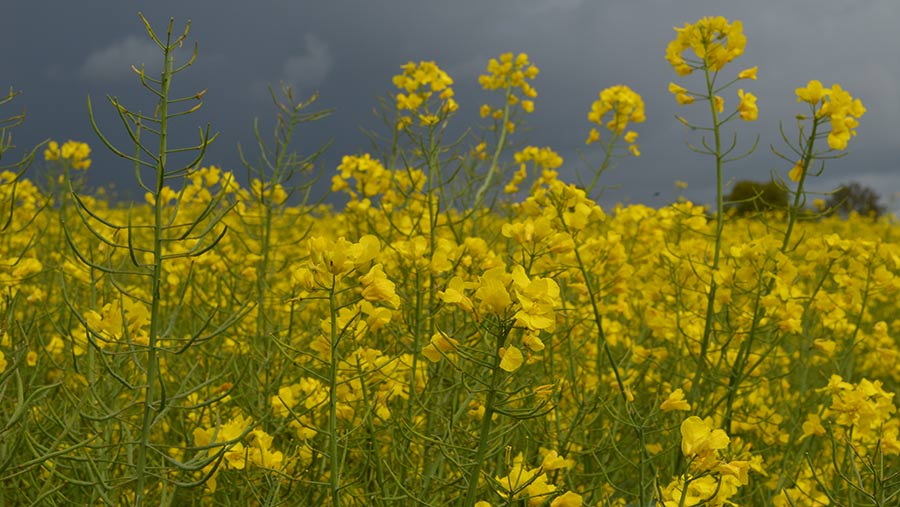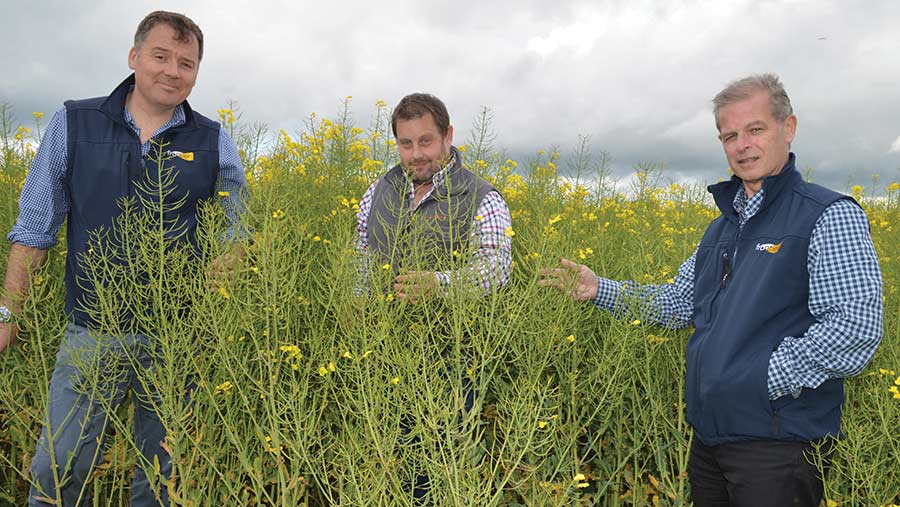Derby OSR grower attracted to Hear varieties by premium
 © MAG/David Jones
© MAG/David Jones Robert Holmes has turned to growing high erucic acid rapeseed (Hear) on his Derbyshire farm, encouraged by a healthy price premium and its easiness to grow, while he has just signed up for a fixed price of £700/t for harvest 2024.
The market for Hear crops is growing at 25% a year, with major oilseeds crusher Cargill optimistic for further growth for its use as a polymer additive for industrial uses, rather than as vegetable oil for human consumption.
See also: Variety blends: Do they work in oilseed rape?
Robert is pleased with his second successive Hear crop, which looked promising in late spring considering the only input it had had before flowering was fertiliser, as it had been too wet a season for the sprayer to venture into the field.
“We are growing the Hear rapeseed because of the premium, while it’s easy to grow and needed by the market. It also takes a lot of stress out of growing oilseed rape,” he tells Farmers Weekly.
Vigorous growth
The Hear variety he is growing is the hybrid Ramses, which shows vigorous growth in the autumn, helping it to escape any potential threats from cabbage stem flea beetle (CSFB). In his first Hear harvest in 2022, the variety yielded 3.75t/ha.
“The rapeseed was up and out of the ground within three days. Within a week there were two leaves out, it was knee-high by November, and was grazed off by sheep in January,” he adds.
Robert is growing a similar area of 40ha to that in the previous season on the family-run Parkstyle Farm at Rodsley, just south of Ashbourne, where the family farms 440ha of largely heavy clay soil. It has 320ha in arable and the rest in permanent pasture for a dairy herd and followers.
Harry Abell, senior agronomist with advisory and trading group Frontier, says Ramses has out-yielded all other varieties in his company’s trials, and the 2022 harvested crop on the Derbyshire farm was grown with a relatively low level of inputs.
“The variety is very impressive with its speed of development, and it is the fastest developing variety I have even seen in the autumn, while it is also fast developing in the spring,” says Harry.

Left to right: Harry Abell, Robert Holmes and Mark Askew © MAG/David Jones
Hear area
The UK Hear area this season is about 30,000ha, less than 10% of the total oilseed rape estimated to be in the ground late last year by the AHDB Early Bird survey at 416,000ha.
This season’s Hear crop is likely to produce 100,000t, while the 2023 total harvest is expected to be above the 1.36m tonnes in 2022, due to the 14% bigger national rapeseed area.
Mark Askew, Frontier’s speciality crops trader, says there is an expanding market across the globe for the polymer additives made from Hear oil.
Cargill is forecasting significant growth in the market over the next five to 10 years and is keen for more UK-produced Hear.
“The crop is priced to attract growth with a £125/t premium over the base oilseed rape price for harvest 2023, and a fixed price of £700/t for harvest 2024,” he says.
This premium and the fixed price are without an oil bonus, which can normally account for an extra 9-10% on the price of traditional oilseed rape. Currently, the spot price for conventional oilseed rape has drifted down to just above £300/t.
Crushing plant
Frontier has an exclusive deal with Cargill’s oilseed rape crushing plant at Liverpool and supplies the plant with 70,000t of UK-grown Hear, with the rest of the UK crop going abroad for crushing.
Frontier is 50% owned by Cargill, with the other 50% being owned by British Sugar-owner Associated British Foods.
Since Cargill closed its oilseed rape crushing plant at Hull last December, all Hear is crushed at Liverpool.
Britain’s two other crushers, ADM at Erith in Kent and Yelo in Warwickshire, do not process any Hear.
Robert returned to winter oilseed rape last season after two seasons trying spring rapeseed in a six-year rotation of winter barley, oilseed rape, winter wheat, spring barley, spring beans and winter wheat.
Farm facts: Parkstyle Farm, Rodsley, Ashbourne, Derbyshire
- Farming 440ha, of which 320ha is in arable and the rest is in grass for a dairy herd
- Six-year arable rotation: winter wheat, winter barley, oilseed rape, winter wheat, spring barley, spring beans
Last season his variable costs were relatively light at £357/ha, made up of £115/ha on seed, £161/ha on sprays and £81/ha on 130kg/ha of nitrogen from a nitrogen-sulphur fertiliser.
The spray costs included three autumn herbicides, one plant growth regulator and two fungicides – one in the autumn and one flowering spray in the spring.
With no blackgrass on the farm, the herbicide spend was generally low, with no propyzamide (Kerb) needed.
An autumn fungicide of tebuconazole (Tesoro) was used to protect against light leaf spot, tank mixed with plant growth regulator mepiquat-chloride and metconazole (Caryx), while the flowering fungicide was a mix of bixafen, prothioconazole and tebuconazole (Skyway).
This season’s crop
For this season, as soon as the preceding winter barley crop was harvested and straw baled, biosolids were applied and then a low-disturbance subsoiler was used.
The ground was sown on August 15, following some summer rain, with the farm’s Claydon 3m strip-till drill at 40 seeds/sq m and consolidated with two passes of Cambridge rolls.
The vigorous nature of the hybrid variety helped it put down good roots, which subsequently put the crop in a good position to cope with the drought in the spring and early summer of 2022.
The crop continued to grow through the autumn and was knee high by November, so it was grazed off by a neighbour’s sheep flock in January, helping to alleviate any potential problems with CSFB larvae.
Spring nitrogen levels were a modest 130kg/ha from a nitrogen-sulphur compound, with 50kg/ha of nitrogen applied in early March and 80kg/ha in mid-April.
The one difference to agronomy this season is the application of the foliar urea polymer Nutrino Pro at post-flowering in late May to provide the equivalent of 30kg/ha of nitrogen to improve yields and quality.
The product contains controlled-release nitrogen along with magnesium and sulphur, in addition to biostimulants.
This summer, Robert says he will be looking to drill another 40ha, and although it is a “monster” to harvest, he has been very pleased with its performance and yield.
“It has certainly taken a lot of the stress and risk out of growing the crop,” he says.

